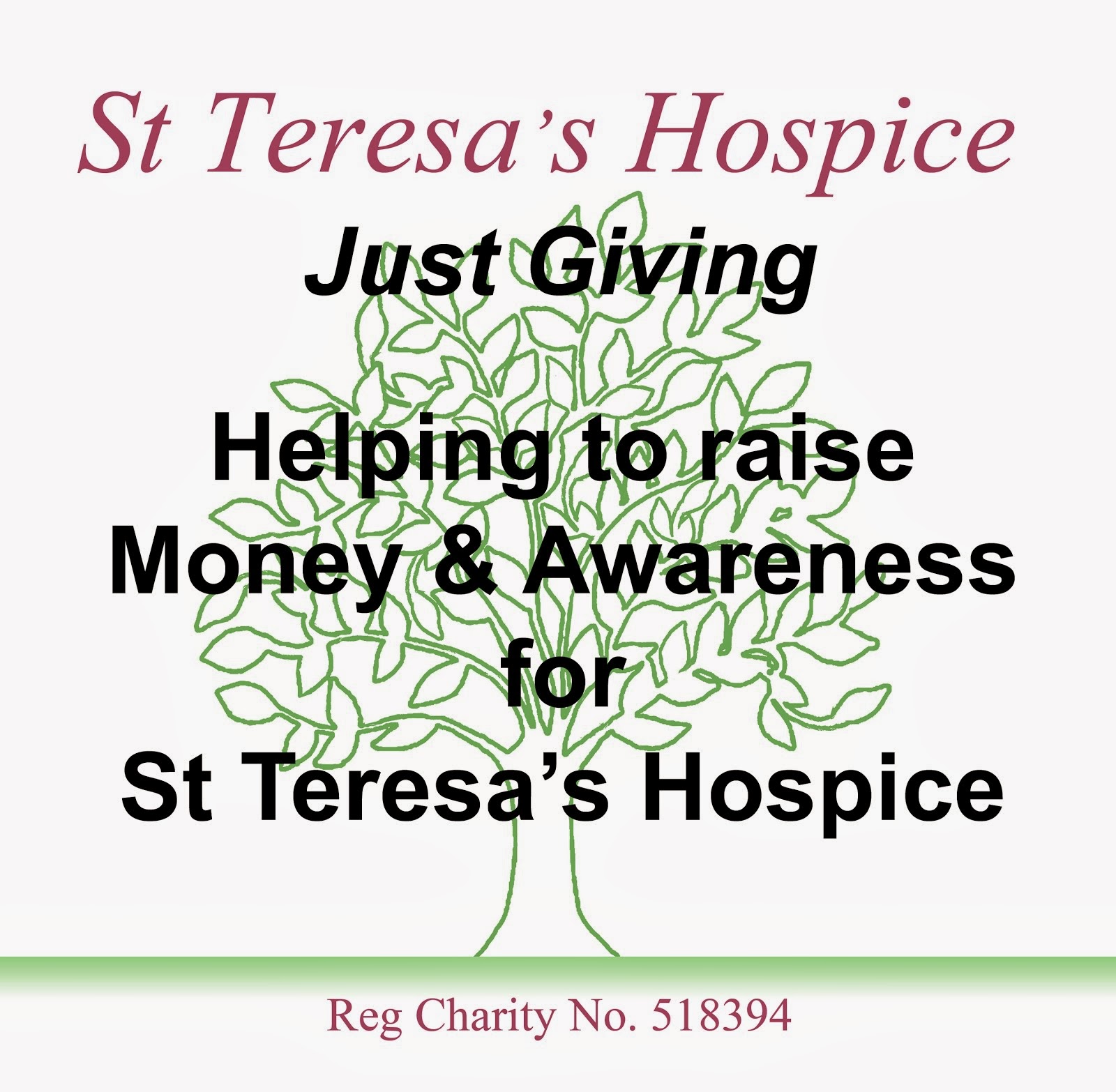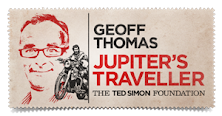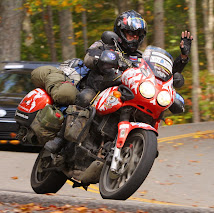
For those uninterested or unaffected by the current economic conditions, then this is an ideal time to go browsing elsewhere. I’ll return to biking matters in the next post, but to celebrate the first anniversary of Financial Armageddon, the following is my layman’s take on the why’s and how’s of last years financial meltdown.
One year ago this week, I was riding happily across America with a fistful of dollars and not a care in the world. Tents and motorbikes are not the most media friendly environments, but despite being divorced from economic reality, it was impossible to overlook the simultaneous collapse of the world’s banking system. Gas stations were the ideal place to freely read the front pages of newspapers like ‘USA Today’ and the road was the ideal place from which to observe the economic effects on everyday people. Possessions in front yards were labelled with handwritten ’For Sale’ signs and ’U-Haul’ trailers were carrying the possessions of the displaced in every possible direction. The population of Middle-America was selling-up and moving-on. The world had changed overnight, Wall Street had collapsed and Main Street was ’For Sale’.
Collateralized Debt Obligations (
CDO‘s), Credit Default Swaps (
CDS’s), Asset Backed Securities (ABS’s), Contracts For Difference (
CFD‘s). For most people, these terms might as well be from an alien based language and that’s exactly why the Banker’s developed them. Such terms are designed to impress us into a false sense of security and to prevent us from asking questions that we fear might leave us looking stupid. Complex financial instruments are not a new concept, they’
ve been in use since the 11
th century, so why did it all go so horribly pear-shaped in 2007? The answer is basically ‘Greed’ and below is my layman’s explanation of why things went so horribly wrong.
Building Societies were great institutions. If you had excess cash, you invested it into a savings account and the Building Society paid you a regular rate of interest. In order to afford the interest that they paid on the savings, the Building Society lent out those savings to people who wanted to buy, and more importantly could afford to buy, a home. The interest charged on the ’Mortgage’ was 8% and the interest paid on the ’Savings’ was 3%. The Building Society enjoyed a margin of perhaps 5% that would cover it's operating costs. If the new homeowner stopped making the monthly loan repayments, then the Building Society would recoup their losses by repossessing the house and selling it back into the market. Each Building Society shouldered the risk of every loan that it made. To reduce this risk to an absolute minimum, the Building Society vetted the mortgage applicants and only loaned money to those people that they deemed to be financially worthy and had a healthy initial deposit. The ’Mortgagee’s’ got their homes, the ‘Savers’ got their interest payments and the Building Society ’Members’ shared in the organisations success. It all worked remarkably well, but each Building Society was limited to lending out in mortgages no more than they received in savings. The management of Building Societies began to change and governments encouraged the development of home ownership, the Retail Banks became more aggressive in the residential mortgage markets and the Building Societies looked on in envy. A Building Society’s capital came from the savings deposited by it’s members, but a Retail Bank was owned by shareholders and could borrow additional capital on the open market. Retail Banks had a seemingly unfair advantage and the answer was quite simple ……. Building Societies would become Retail Banks.
We all got our Halifax and Abbey National Shares, the names on the High Street began to change, our regional Building Society became a Retail Bank, the Retail Bank was then swallowed up by an International Retail Bank and the International Retail Bank bought a sexy little Investment Bank with a nice address in London EC3. These new megalithic Financial Institutions had cheap money thrown at them from every direction, annual profits rose and the decimal points moved to the right on the rocket scientists bonus cheques. House prices were rising. Regan, Clinton, Bush, Thatcher and Blair all encouraged the concept and reality of home ownership. New money flooded into the housing market, mortgages once only available to Mr Prime were now being made available to his less reliable half-brother, Mr Sub-Prime. The profit margins were good, Mr Sub-Prime was less worthy than his half-brother and therefore paid a higher rate of interest. He kept up his repayments, why
wouldn’t he? His house was rising in value every year. If financially things became a little difficult for him then it
wasn‘t really a major drama because a no-questions asked re-mortgage was never more than a mouse-click away. Everything in the financial garden was flourishing and everybody was much more financially aware than the generation before, ’Risk’ was no longer an important factor.
The Rocket Scientists at Investment Banks such as Lehman Brothers, had rediscovered the
CDO, the Consolidated Debt Obligation. For the Retail Bank this was a way of reducing the risk involved with homeowners defaulting on their mortgage repayments and for the Investment Bank, often part of the same institution, it was just an amazing way to sell the same profitable product several times over. A
CDO is basically a box-file, a container for documents, in this case those documents are Mortgages. Into that container, a bank will put a selection of it’s own mortgages, otherwise known as ’Debt Obligations’, and attach a value to the box, a selling price. Human and corporate nature being what it is, the Retail Bank will hide a few of it’s Mr Sub-Prime Mortgages in with it’s gold-plated Mr Prime versions, thus off-loading some of it‘s more dangerous loans. The Investment Bank buy’s a van full of boxes from various Retail Banks, shuffles the documents into larger boxes, attaches a new selling price to each new box and finds a willing buyer. It works well, each sale generates a small profit and each container can be rearranged and sold again and again. Each subsequent box becomes so big and so diverse in quality, that it becomes impossible to assess the true value of it’s contents. These boxes are on a merry-go-round, Banks are re-purchasing bad mortgages that they’d off-loaded weeks earlier, but now at a slightly inflated price. Finally, somebody asks the sixty-four billion dollar question -
’’why is this box full of crap?’’
The answer to that sixty-four billion dollar question is
CDS, the Credit Default Swap. It’s not really an answer to the sensible question, it’s more of an escape mechanism that deems a meaningful answer unnecessary. The fact is that the there is no real ‘answer’, nobody can really understand what the hell is in each box. The boxes of mortgages are now so far removed from the original lenders that even the Bank’s Rocket Scientists can‘t calculate an accurate value for it‘s contents. The reaction of the Bankers is to
bury their heads in the communal caviar, continue turning the profits on the
CDO’s and to introduce an additional means of making new profits; the
CDS.
It’s almost perfect. When the Bank sells
CDO, a box of assorted mortgages, it now sells an insurance policy that sits happily alongside it, a Credit Default Swap. The Bank charges an additional premium for the
CDS, and if the underlying mortgage asset turns sour, then they compensate the buyer accordingly. At the same time, when the Bank buys a box of assorted mortgages, it buys a Credit Default Swap as part of the same deal. The risk is spread again, everyone is protected and more profits are being made. Suddenly, the world’s largest insurance group
AIG, pricks up it’s ears and wonders why it’s missing out on what they deem to be ’Insurance’ business. The Investment Banks are more than happy to let
AIG in on the action. I can just imagine an
AIG underwriter looking into a billion dollar box of assorted mortgages that’s passed twenty times through various institutions and wondering '
WTF?' Long story short,
AIG seem to accept the ’Retail Price’ stamped on each box, they collect the premium for providing the
CDS and announce record annual profits on the back of this entirely new business. By the end of 2007, the global trade in
CDS’s exceeded $60,000,000,000,000.00, that’s sixty trillion dollars.
Historically, a Building Society could lend no more money than it held in savings. Their profit was limited by the amount of money that they had available to them. By the end of 2007, many Investment Banks were leveraged to a factor of forty. This means that they had borrowed amounts equal to around forty times their actual value, forty times more than they were worth. To put that into context, it’s equivalent to a person earning two thousand pounds a month taking on a mortgage of one million pounds, it’s financial suicide. Adding to this leverage problem, the loans taken on by these Banks were in nature, short-term, but these loans were used to purchase mortgages, which are long-term. The situation was beyond precarious, the entire worlds financial stability rested on the value of our houses.
Much of governmental economic thinking revolves around controlling the rate of inflation. The rate of inflation is determined indirectly by the supply of money, and the supply of money is determined in part by interest rates. As higher inflation became a possibility, Interest rates began to rise which meant that monthly loan and mortgage repayments increased. Added to this problem, many of the Mr Sub-Prime mortgages were falling from their ‘Introductory Discounted Rates’ and homeowners were confronted with a double whammy. The housing market slowed and homeowners began to default on their monthly repayments. Houses were repossessed, new buyers stopped entering the market and prices fell further. A vicious circle had begun. The Banks also had massively increased repayments on their own debts which added pressure to their already overstretched cash holdings. They were no longer able to loan money to other institutions, the financial squeeze was coming from all sides. Northern Rock were the first to break cover. The short-term loans that they’d used to provide long-term mortgages for their customers were not being renewed, they quickly ran out of money. Northern Rock approached the Bank of England and the first run on a British Bank in living memory began. To the public, the failure of Northern Rock was reported as a blip, the result of a flawed business model, an individual case of gross mismanagement. The rest is history; Fannie Mac & Freddie Mae, Bear Sterns, Bradford &
Bingley. Lehman Brothers bankrupt,
Lloyds saving
HBoS and
RBS falling into government hands.
The Banks got greedy and the greed was rewarded with the payment of stellar salaries and bonuses. Smoke and mirrors were used to disguise the true value of their business transactions. Profits and bonuses were annual calculations but the mortgages upon which those profits were based were not. Governments were happy with the application of soft-touch regulation for financial institutions while they spent the enormous tax income on popular vote winning projects. Nobody emerges from this global fiasco looking good, but some will emerge looking wealthy. Unfortunately, those are the same people who’s actions created this whole mess in the first place. Governments and Customers don’t design and sell complex financial instruments …. That’s all down to the Bankers.
www.justgiving.com/geoffgthomas




















